The vertical induction hardening system market is projected to grow from USD 1.3 billion in 2025 to USD 2.0 billion by 2035, supported by increasing demand for precise and energy-efficient heat treatment processes across global manufacturing sectors. Key dynamics are being shaped by the rapid expansion of automotive powertrain, drivetrain, and precision machining operations, where components such as shafts, gears, axles, bearings, and transmission parts require controlled surface hardening to improve fatigue strength and wear resistance. Vertical induction systems provide consistent heat distribution, repeatable hardening depths, and minimal distortion, making them increasingly preferred over conventional furnace-based processes. As component tolerances tighten and lightweight metal designs advance, manufacturers are prioritizing induction systems that deliver metallurgical uniformity and reduce post-processing requirements.
Technology integration is also influencing market progression. Systems equipped with real-time temperature monitoring, closed-loop feedback control, automated coil positioning, and CNC-based hardening patterns are becoming essential for high-volume production environments. The capability to harden complex geometries and multi-step profiles without manual adjustment is driving adoption in aerospace and railway component production. Additionally, the shift toward energy-efficient and environmentally cleaner production lines is accelerating the transition from gas-fired heat treatment to induction systems that offer rapid heating cycles and lower operating costs.
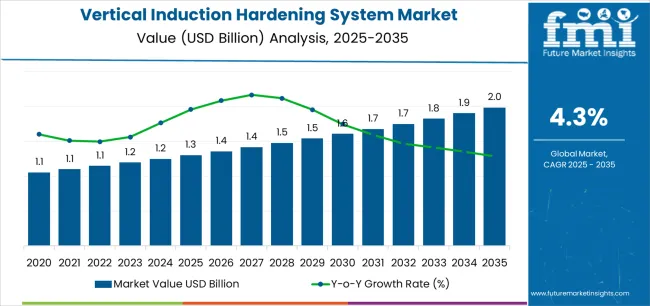
The latter half (2030-2035) will witness sustained growth from USD 1.6 billion to USD 2.0 billion, representing an addition of USD 382.4 million or 55% of the decade's expansion. This period will be defined by mass market penetration of specialized vertical hardening configurations, integration with comprehensive manufacturing execution platforms, and seamless compatibility with existing heat treatment infrastructure. The market trajectory signals fundamental shifts in how manufacturers approach surface hardening optimization and component quality management, with participants positioned to benefit from sustained demand across multiple frequency types and end-use application segments.
The vertical induction hardening system market demonstrates distinct growth phases with varying market characteristics and competitive dynamics. Between 2025 and 2030, the market progresses through its technology adoption phase, expanding from USD 1.3 billion to USD 1.6 billion with steady annual increments averaging 4.3% growth. This period showcases the transition from basic induction hardening configurations to advanced high-frequency systems with enhanced depth control capabilities and integrated quality monitoring becoming mainstream features.
The 2025-2030 phase adds USD 309.8 million to market value, representing 45% of total decade expansion. Market maturation factors include standardization of surface hardening and heat treatment protocols, declining component costs for specialized induction configurations, and increasing manufacturer awareness of vertical hardening benefits reaching 95-98% case depth consistency effectiveness in automotive and aerospace applications. Competitive landscape evolution during this period features established heat treatment equipment manufacturers like EMA Indutec and Inductotherm expanding their vertical system portfolios, while specialty manufacturers focus on advanced frequency development and enhanced metallurgical capabilities.
From 2030 to 2035, market dynamics shift toward advanced frequency integration and global manufacturing expansion, with growth continuing from USD 1.6 billion to USD 2.0 billion, adding USD 382.4 million or 55% of total expansion. This phase transition centers on specialized induction hardening systems, integration with automated heat treatment networks, and deployment across diverse automotive and railway manufacturing scenarios, becoming standard rather than specialized applications. The competitive environment matures with focus shifting from basic surface hardening capability to comprehensive metallurgical optimization systems and integration with production monitoring platforms.
| Metric | Value |
|---|---|
| Market Value (2025) | USD 1.3 billion |
| Market Forecast (2035) | USD 2.0 billion |
| Growth Rate | 4.3% CAGR |
| Leading Technology | High Frequency Operating Type |
| Primary Application | Automotive Application Segment |
The market demonstrates strong fundamentals with high frequency induction systems capturing a dominant share through advanced hardening control and metallurgical optimization capabilities. Automotive applications drive primary demand, supported by increasing precision component manufacturing and superior surface hardness requirements. Geographic expansion remains concentrated in developed markets with established heat treatment infrastructure, while emerging economies show accelerating adoption rates driven by automotive industry expansion and rising quality standards.
Market expansion rests on three fundamental shifts driving adoption across the automotive, aerospace, and railway sectors. First, component durability demand creates compelling metallurgical advantages through vertical induction hardening systems that provide immediate surface hardness enhancement and wear resistance without compromising core toughness, enabling manufacturers to meet stringent performance standards while maintaining production efficiency and reducing post-processing requirements. Second, heat treatment modernization accelerates as component manufacturers worldwide seek advanced induction systems that complement traditional hardening processes, enabling precise case depth control and quality assurance that align with industry standards and material specifications.
Third, production efficiency enhancement drives adoption from precision manufacturers and heavy industry operations requiring effective hardening solutions that maximize component lifespan while maintaining operational consistency during high-volume processing and automated manufacturing operations. However, growth faces headwinds from equipment investment cost challenges that vary across induction suppliers regarding the complexity of power electronics and vertical configuration engineering, which may limit adoption in cost-sensitive manufacturing environments. Technical limitations also persist regarding component geometry constraints and fixture design requirements that may reduce effectiveness in complex part production scenarios, which affect processing flexibility and tooling investment requirements.
The vertical induction hardening system market represents a specialized yet critical heat treatment opportunity driven by expanding global automotive production, manufacturing technology modernization, and the need for superior surface hardening in diverse component applications. As manufacturers worldwide seek to achieve 95-98% case depth consistency effectiveness, reduce distortion, and integrate advanced induction systems with automated platforms, vertical hardening products are evolving from basic heat treatment equipment to sophisticated metallurgical solutions ensuring component quality and performance leadership.
The market's growth trajectory from USD 1,322.1 million in 2025 to USD 2,014.3 million by 2035 at a 4.3% CAGR reflects fundamental shifts in heat treatment technology requirements and surface hardening optimization. Geographic expansion opportunities are particularly pronounced in Asia Pacific markets, while the dominance of high frequency induction systems and automotive applications provides clear strategic focus areas.
Strengthening the dominant high frequency segment through enhanced case depth precision, superior energy efficiency, and rapid heating capabilities. This pathway focuses on optimizing power delivery, improving hardening consistency, extending operational effectiveness to 95-98% depth control rates, and developing specialized configurations for diverse component applications. Market leadership consolidation through advanced induction engineering and precise frequency control integration enables premium positioning while defending competitive advantages against medium frequency alternatives. Expected revenue pool: USD 180-230 million
Rapid automotive production and component manufacturing growth across Asia Pacific creates substantial expansion opportunities through local equipment manufacturing capabilities and technology transfer partnerships. Growing automotive industry and government manufacturing initiatives drive sustained demand for advanced vertical hardening systems. Localization strategies reduce import costs, enable faster technical support, and position companies advantageously for procurement programs while accessing growing domestic markets. Expected revenue pool: USD 145-190 million
Expansion within the dominant automotive segment (55.0% market share) through specialized vertical hardening designs addressing drivetrain component standards and high-volume production requirements. This pathway encompasses automated loading systems, quality control integration, and compatibility with diverse manufacturing processes. Premium positioning reflects superior surface hardness performance and comprehensive metallurgical compliance supporting modern automotive production. Expected revenue pool: USD 125-165 million
Strategic expansion into aerospace applications (25.0% market share) requires enhanced process control capabilities and specialized hardening configurations addressing critical component operational requirements. This pathway addresses stringent material traceability, documentation enhancement, and aerospace certification compatibility with advanced metallurgical engineering for demanding safety standards. Premium pricing reflects specialized hardening requirements and extended process validation. Expected revenue pool: USD 105-145 million
Development of specialized vertical hardening configurations for railway applications (12.0% share) and other segments (8.0%), addressing specific component requirements and industrial hardening demands. This pathway encompasses heavy-duty system designs, cost-optimized alternatives, and application-specific solutions for diverse transportation environments. Technology differentiation through tailored hardening capabilities enables diversified revenue streams while reducing dependency on single application platforms. Expected revenue pool: USD 85-120 million
Expansion of medium frequency segment (45.0% market share) through enhanced penetration depth, broader component compatibility, and versatile hardening requirements. This pathway encompasses larger component applications, deeper case depth operations, and conventional hardening installations requiring reliable metallurgical characteristics. Market development through optimized induction engineering enables differentiated positioning while accessing applications requiring deeper hardening solutions. Expected revenue pool: USD 75-105 million
Development of advanced vertical hardening configurations addressing automation requirements and smart manufacturing integration across automotive and aerospace applications. This pathway encompasses real-time monitoring, predictive maintenance capabilities, and comprehensive process documentation. Premium positioning reflects technological leadership and digitalization expertise while enabling access to smart factory procurement programs and automated production partnerships. Expected revenue pool: USD 65-90 million
Primary Classification: The market segments by operating frequency into High frequency and Medium frequency categories, representing the evolution from conventional hardening systems to specialized configurations for comprehensive surface treatment optimization.
Secondary Classification: Application segmentation divides the market into Automotive, Aerospace, Railway, and Other sectors, reflecting distinct requirements for hardening depth, component geometry, and material performance standards.
Regional Classification: Geographic distribution covers Asia Pacific, Europe, North America, and other regions, with developed markets leading adoption while emerging economies show accelerating growth patterns driven by automotive manufacturing expansion programs.
The segmentation structure reveals technology progression from standard induction hardening configurations toward specialized frequency systems with enhanced case depth control and automation capabilities, while application diversity spans from automotive driveline components to specialized aerospace and railway parts requiring precise surface hardening solutions.
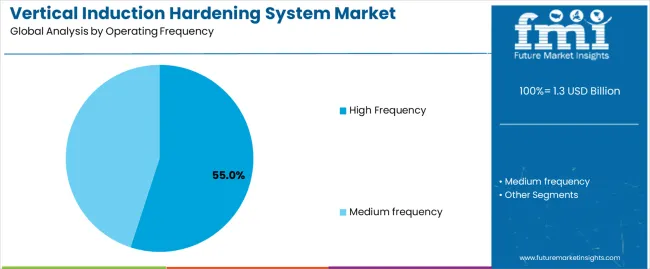
Market Position: High frequency induction systems command the leading position in the vertical induction hardening system market with approximately 55.0% market share through advanced metallurgical properties, including shallow case depth precision, rapid heating capability, and energy optimization that enable manufacturers to achieve optimal surface hardness across diverse component geometries and production environments.
Value Drivers: The segment benefits from manufacturer preference for efficient hardening systems that provide consistent case depth results, reduced energy consumption, and precise heat-affected zone control without requiring extensive process modifications. Advanced frequency features enable automated hardening operations, quality consistency, and integration with existing heat treatment protocols, where depth precision and energy efficiency represent critical production requirements.
Competitive Advantages: High frequency induction systems differentiate through proven shallow hardening control, fast cycle times, and integration with precision manufacturing protocols that enhance hardening effectiveness while maintaining optimal metallurgical properties suitable for diverse demanding applications.
Key market characteristics:
Medium frequency induction systems maintain versatile positioning in the vertical induction hardening system market due to their deeper penetration properties and broader component compatibility advantages. These systems appeal to manufacturers requiring deeper case depth capability with adequate performance for larger component applications. Market adoption is driven by heavy component manufacturing expansion, emphasizing reliable hardening and operational flexibility through proven induction technology while maintaining comprehensive process capabilities.
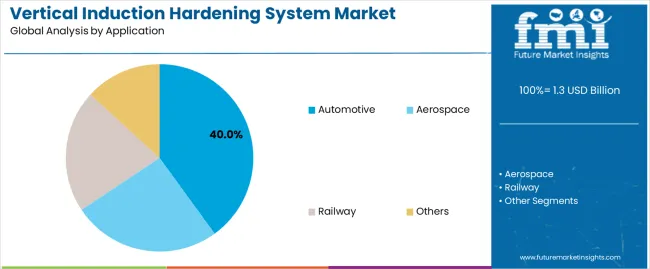
Market Context: Automotive applications dominate the vertical induction hardening system market with approximately 40% market share due to widespread adoption of surface hardening technology and increasing focus on component durability, wear resistance, and manufacturing efficiency applications that minimize distortion while maintaining production standards.
Appeal Factors: Automotive manufacturers prioritize hardening reliability, process consistency, and integration with existing production infrastructure that enables coordinated vertical hardening application across multiple component lines. The segment benefits from substantial automotive manufacturing investment and quality programs that emphasize the acquisition of induction hardening systems for performance enhancement and cost reduction applications.
Growth Drivers: Automotive production expansion programs incorporate vertical induction hardening systems as standard heat treatment for drivetrain component operations, while electric vehicle growth increases demand for specialized hardening capabilities that comply with performance standards and minimize weight penalties.
Market Challenges: Varying component designs and material specifications may limit hardening standardization across different production facilities or vehicle platforms.
Application dynamics include:
Aerospace applications capture approximately 25.0% market share through specialized hardening requirements in landing gear manufacturing, engine component production, and critical part applications. These operations demand premium vertical hardening systems capable of delivering exceptional surface properties while providing comprehensive process documentation and material traceability.
Railway applications account for approximately 20% market share, while other segments capture 15%, including wheel axle components, coupling systems, and specialized industrial hardening requiring vertical induction capabilities for durability optimization and component performance.
Growth Accelerators: Automotive component production expansion drives primary adoption as vertical induction hardening systems provide superior surface hardness capabilities that enable manufacturers to meet stringent wear resistance standards without excessive processing costs, supporting component operations and manufacturing missions that require precise metallurgical treatment applications. Heat treatment technology infrastructure demand accelerates market expansion as component producers seek effective hardening systems that minimize distortion while maintaining operational effectiveness during high-volume processing and automated manufacturing scenarios. Production investment spending increases worldwide, creating sustained demand for surface hardening systems that complement traditional heat treatment processes and provide performance enhancement in precision component environments.
Growth Inhibitors: Equipment investment cost challenges vary across induction suppliers regarding the complexity of vertical configuration and power electronics integration, which may limit operational flexibility and market penetration in regions with budget constraints or cost-sensitive manufacturing operations. Technical performance limitations persist regarding component geometry constraints and fixture design requirements that may reduce effectiveness in complex part configurations or small batch conditions, affecting processing versatility and tooling investment requirements. Market fragmentation across multiple industry standards and component specifications creates compatibility concerns between different induction suppliers and existing heat treatment infrastructure.
Market Evolution Patterns: Adoption accelerates in automotive drivetrain and aerospace landing gear sectors where component performance justifies induction hardening investment costs, with geographic concentration in developed markets transitioning toward mainstream adoption in emerging economies driven by automotive manufacturing expansion and quality awareness. Technology development focuses on enhanced frequency control, improved automation integration, and compatibility with smart manufacturing systems that optimize hardening performance and production effectiveness. The market could face disruption if alternative surface hardening technologies or laser-based innovations significantly limit the deployment of vertical induction systems in manufacturing applications, though induction hardening's unique combination of controlled depth, production efficiency, and proven metallurgical results continues to make it preferred in high-volume component production.
The Vertical Induction Hardening System market demonstrates varied regional dynamics with Growth Leaders including China (5.8% CAGR) and India (5.4% CAGR) driving expansion through automotive capacity additions and component manufacturing development programs. Steady Performers encompass Germany (4.9% CAGR), Brazil (4.5% CAGR), and United States (4.1% CAGR), benefiting from established automotive industries and advanced heat treatment technology adoption. Mature Markets feature United Kingdom (3.7% CAGR) and Japan (3.2% CAGR), where specialized precision component applications and aerospace integration support consistent growth patterns.
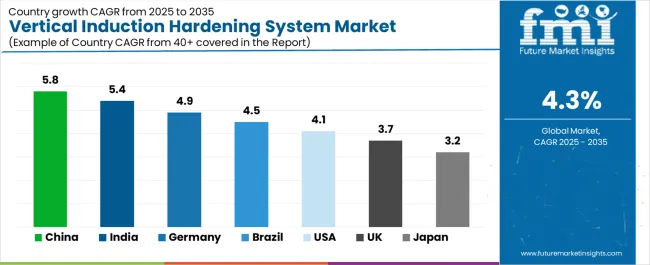
| Country | CAGR (2025-2035) |
|---|---|
| China | 5.8% |
| India | 5.4% |
| Germany | 4.9% |
| Brazil | 4.5% |
| United States | 4.1% |
| United Kingdom | 3.7% |
| Japan | 3.2% |
Regional synthesis reveals Asia Pacific markets leading adoption through automotive manufacturing expansion and heat treatment technology infrastructure development, while European countries maintain steady expansion supported by precision engineering technology advancement and quality standardization requirements. North American markets show moderate growth driven by automotive component applications and aerospace manufacturing integration trends.
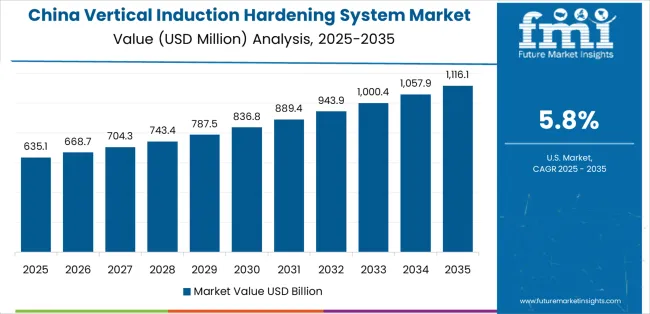
The Chinese market emphasizes advanced hardening features, including precision case depth control and integration with comprehensive manufacturing execution platforms that manage surface hardness, quality monitoring, and production optimization applications through unified automation systems. The country demonstrates strong growth at 5.8% CAGR, driven by automotive manufacturing expansion, heat treatment modernization initiatives, and emerging electric vehicle component development that support vertical hardening integration. Chinese manufacturers prioritize operational effectiveness with vertical induction hardening systems delivering consistent surface treatment through advanced frequency capabilities and production adaptation features.
Technology deployment channels include major automotive component suppliers, specialized heat treatment equipment providers, and manufacturing procurement programs that support professional applications for complex drivetrain hardening and precision component applications. Production platform integration capabilities with established automotive systems expand market appeal across diverse operational requirements seeking reliable hardening and quality benefits. The expanding automotive manufacturing base and accelerating new energy vehicle production create sustained demand, while innovative applications in railway components and industrial machinery open new growth avenues.
Performance Metrics:
Advanced automotive market in Germany demonstrates sophisticated vertical hardening deployment with documented metallurgical effectiveness in precision component applications and specialty manufacturing facilities through integration with existing heat treatment systems and quality infrastructure. The country leverages engineering expertise in induction technology and manufacturing systems integration to maintain strong growth at 4.9% CAGR. Industrial centers, including Baden-Wurttemberg, Bavaria, and North Rhine-Westphalia, showcase premium installations where vertical hardening systems integrate with comprehensive production platforms and quality management systems to optimize component performance and metallurgical effectiveness.
German manufacturers prioritize equipment precision and EU compliance in vertical hardening selection, creating demand for advanced induction systems with features, including automated process control and documentation systems. The market benefits from established automotive component infrastructure and a willingness to invest in heat treatment technologies that provide long-term performance benefits and compliance with international automotive and quality standards.
Market Intelligence Brief:
The USA vertical induction hardening system market demonstrates sophisticated deployment across component applications with documented effectiveness in aerospace manufacturing and automotive production facilities through integration with comprehensive quality management systems and heat treatment infrastructure. The country leverages advanced engineering capabilities in metallurgical science and automation technologies to maintain moderate growth at 4.1% CAGR. Industrial centers, including Michigan, Ohio, and California, showcase premium installations where vertical hardening systems integrate with comprehensive production platforms and aerospace certification networks to optimize surface hardness quality and manufacturing effectiveness.
American manufacturers prioritize process control and quality compliance in vertical hardening development, creating demand for certified induction systems with features, including real-time monitoring and validation capabilities. The market benefits from established aerospace component infrastructure and willingness to invest in heat treatment technologies that provide long-term performance benefits and compliance with FAA and automotive standards.
Market Intelligence Brief:
The UK vertical induction hardening system market demonstrates advanced quality deployment with documented metallurgical effectiveness in automotive component applications and aerospace facilities through integration with existing quality compliance systems and heat treatment infrastructure. The country leverages engineering expertise in precision manufacturing and heat treatment systems integration to maintain steady growth at 3.7% CAGR. Industrial centers, including West Midlands, Yorkshire, and East Midlands, showcase installations where vertical hardening systems integrate with comprehensive quality platforms and manufacturing management systems to optimize regulatory compliance and metallurgical effectiveness.
British manufacturers prioritize equipment quality and regulatory compliance in vertical hardening development, creating demand for certified induction systems with features, including process documentation and performance tracking. The market benefits from established automotive component infrastructure and commitment to invest in heat treatment technologies that provide long-term quality benefits and compliance with UK and EU manufacturing standards. Automotive drivetrain applications, aerospace component systems, and quality-focused manufacturing programs drive diversified demand across multiple application segments.
Strategic Market Indicators:
Vertical induction hardening system market in India demonstrates rapid expansion deployment with documented metallurgical effectiveness in automotive component applications and manufacturing facilities through integration with emerging heat treatment systems and production infrastructure. The country leverages growing engineering capabilities in manufacturing equipment and induction systems integration to achieve high growth at 5.4% CAGR. Industrial centers, including Maharashtra, Tamil Nadu, and Gujarat, showcase expanding installations where vertical hardening systems integrate with comprehensive production platforms and distribution networks to optimize market penetration and surface hardening effectiveness.
Indian manufacturers prioritize equipment accessibility and performance standards in vertical hardening development, creating demand for cost-effective induction systems with features, including simplified operation methods and reliable hardening control. The market benefits from expanding automotive manufacturing infrastructure and willingness to invest in international-standard heat treatment technologies that provide component quality and compliance with global manufacturing standards.
Market Intelligence Brief:
Vertical induction hardening system market in Japan demonstrates precision deployment with documented metallurgical effectiveness in specialty automotive applications and precision component facilities through integration with advanced heat treatment systems and quality control infrastructure. The country leverages engineering excellence in induction precision and manufacturing systems integration to maintain steady growth at 3.2% CAGR. Industrial centers, including Aichi, Osaka, and Kanagawa, showcase installations where vertical hardening systems integrate with comprehensive quality platforms and production systems to optimize metallurgical excellence and surface hardening effectiveness.
Japanese manufacturers prioritize equipment precision and quality excellence in vertical hardening development, creating demand for ultra-premium induction systems with features, including micro-precision control and quality integration systems. The market benefits from established precision component infrastructure and commitment to invest in highest-quality heat treatment technologies that provide superior component positioning and compliance with stringent Japanese manufacturing standards.
Strategic Market Indicators:

The Vertical Induction Hardening System market in Europe is projected to grow substantially over the forecast period, with Germany expected to maintain its leadership position with a significant market share supported by its advanced automotive infrastructure and major component manufacturing centers in Baden-Wurttemberg and Bavaria. France follows with strong market presence, driven by comprehensive automotive component programs and aerospace manufacturing initiatives. The United Kingdom holds substantial market share through specialized drivetrain component activities, quality manufacturing applications, and precision heat treatment operations.
Italy commands notable market presence through strong automotive component and industrial manufacturing projects. Spain accounts for growing market share aided by automotive expansion and component manufacturing adoption. Poland maintains steady share driven by specialty component applications and heat treatment demand. The Rest of Europe region is anticipated to show steady adoption, reflecting consistent growth in Nordic countries, automotive component expansion in Central European markets, and manufacturing upgrades across Eastern European heat treatment facilities.

In Japan, the Vertical Induction Hardening System market prioritizes high frequency induction systems, which capture the dominant share of automotive component and aerospace part installations due to their advanced features, including precision case depth control optimization and seamless integration with existing automated production infrastructure. Japanese manufacturers emphasize quality, precision, and long-term metallurgical excellence, creating demand for high frequency systems that provide exceptional surface hardness capabilities and superior hardening performance based on component requirements and quality standards. Medium frequency systems maintain secondary positions primarily in larger component applications and deeper hardening installations where adequate case depth meets production requirements without compromising operational efficiency.
Market Characteristics:
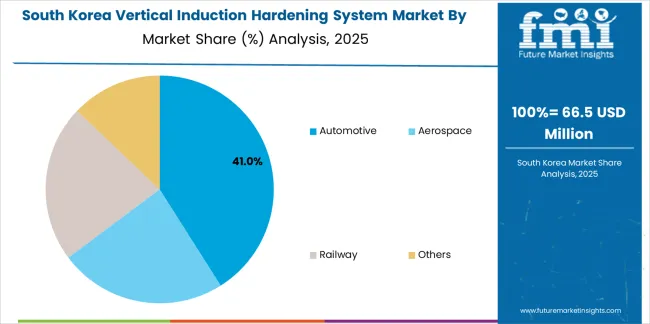
In South Korea, the market structure favors international heat treatment equipment manufacturers, including EMA Indutec, Inductotherm, and regional specialists, which maintain dominant positions through comprehensive product portfolios and established automotive networks supporting both component manufacturing and aerospace production installations. These providers offer integrated solutions combining advanced vertical hardening systems with professional installation services and ongoing technical support that appeal to Korean manufacturers seeking reliable surface hardening systems.
Local equipment distributors and heat treatment contractors capture moderate market share by providing localized installation capabilities and competitive pricing for standard component hardening applications, while domestic manufacturers focus on specialized configurations and cost-effective solutions tailored to Korean automotive market characteristics.
Channel Insights:
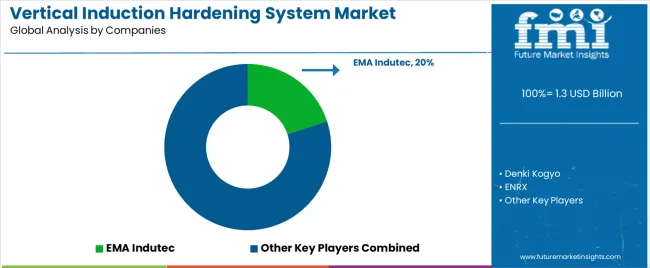
The Vertical Induction Hardening System market operates with moderate concentration, featuring approximately 15-18 meaningful participants, where leading companies control roughly 45-50% of the global market share through established automotive relationships and comprehensive heat treatment equipment portfolios. Competition emphasizes advanced frequency configurations, process reliability, and manufacturing integration rather than price-based rivalry. The leading company, EMA Indutec, commands approximately 20.0% market share through its extensive vertical hardening product line and global automotive presence.
Market Leaders encompass EMA Indutec, Denki Kogyo, and Inductotherm, which maintain competitive advantages through extensive induction expertise, global automotive networks, and comprehensive system integration capabilities that create customer loyalty and support premium pricing. These companies leverage decades of heat treatment experience and ongoing innovation investments to develop advanced vertical hardening systems with precision frequency control and metallurgical consistency features. Technology Innovators include ENRX and regional specialists, which compete through specialized frequency focus and innovative automation capabilities that appeal to manufacturers seeking advanced hardening solutions and production optimization.
These companies differentiate through rapid product development cycles and specialized automotive component application focus. Regional Specialists feature equipment manufacturers focusing on specific geographic markets and specialized applications, including aerospace-grade systems and integrated automation solutions. Market dynamics favor participants that combine reliable induction technology with advanced control capabilities, including precision case depth monitoring and automatic process optimization features. Competitive pressure intensifies as traditional heat treatment equipment suppliers expand into specialty vertical hardening systems, while specialized induction companies challenge established players through innovative frequency solutions and smart monitoring platforms targeting automotive and aerospace component segments.
| Item | Value |
|---|---|
| Quantitative Units | USD 1.3 billion |
| Operating Frequency | High frequency, Medium frequency |
| Application | Automotive, Aerospace, Railway, Others |
| Regions Covered | Asia Pacific, Europe, North America, Latin America, Middle East & Africa |
| Countries Covered | China, India, Germany, Brazil, United States, United Kingdom, Japan, and 20+ additional countries |
| Key Companies Profiled | EMA Indutec, Denki Kogyo, ENRX, Inductotherm, FUJI-DENSHI, SMS Elotherm, Heatking Induction Technology, eldec, SAET EMMEDIM, Maschinenfabrik ALFING Kessler GmbH, Heess, AAGES SA, Chengdu Duolin Electric, HAIRUITUO, Neturen, Duolin Electronics |
| Additional Attributes | Dollar sales by operating frequency and application categories, regional adoption trends across Asia Pacific, Europe, and North America, competitive landscape with heat treatment equipment manufacturers and automotive suppliers, manufacturer preferences for hardening precision and automation capabilities, integration with production platforms and metallurgical monitoring systems, innovations in frequency control and process excellence, and development of smart automation solutions with enhanced performance and manufacturing optimization capabilities. |
The global vertical induction hardening system market is estimated to be valued at USD 1.3 billion in 2025.
The market size for the vertical induction hardening system market is projected to reach USD 2.0 billion by 2035.
The vertical induction hardening system market is expected to grow at a 4.3% CAGR between 2025 and 2035.
The key product types in vertical induction hardening system market are high frequency and medium frequency.
In terms of application, automotive segment to command 40.0% share in the vertical induction hardening system market in 2025.






Full Research Suite comprises of:
Market outlook & trends analysis
Interviews & case studies
Strategic recommendations
Vendor profiles & capabilities analysis
5-year forecasts
8 regions and 60+ country-level data splits
Market segment data splits
12 months of continuous data updates
DELIVERED AS:
PDF EXCEL ONLINE
Vertical Furnace Tube Cleaning Machine Market Size and Share Forecast Outlook 2025 to 2035
Vertical Turbine Pump Market Size and Share Forecast Outlook 2025 to 2035
Vertical Software Market Size and Share Forecast Outlook 2025 to 2035
Vertical Farming Market Size and Share Forecast Outlook 2025 to 2035
Vertical Mill Market Size and Share Forecast Outlook 2025 to 2035
Vertical Form Fill Seal VFFS Machine Market Size and Share Forecast Outlook 2025 to 2035
Vertical Market Software Market Insights - Growth & Forecast 2025 to 2035
Vertical-Cavity Surface-Emitting Lasers (VCSEL) Market Growth - Trends & Forecast 2025 to 2035
Vertical Mast Lifts Market Analysis & Forecast by Product Type, Working Height, Capacity, End-user Industry, and Region Through 2035
North America Vertical Turbine Pump Market Analysis & Forecast by Head, Material Type, Stages, Power Rating, End-use, and Region Through 2035
Vertical Immersion Pumps Market Growth – Trends & Forecast 2025-2035
Vertical Platform Lift Market
Vertical Inline Pumps Market
Vertical Strapping Machines Market
Clipless Vertical Pouches Market
Industrial Vertical Washing Tower Market Size and Share Forecast Outlook 2025 to 2035
Induction Cooktop Market Forecast and Outlook 2025 to 2035
Induction Furnace Market Size and Share Forecast Outlook 2025 to 2035
Induction Hob Market Size and Share Forecast Outlook 2025 to 2035
Induction Sealing Machines Market Size and Share Forecast Outlook 2025 to 2035

Thank you!
You will receive an email from our Business Development Manager. Please be sure to check your SPAM/JUNK folder too.
Chat With
MaRIA